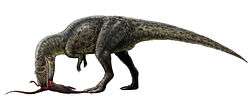Shaochilong
| Shaochilong Temporal range: Late Cretaceous, 92 Ma | |
|---|---|
 | |
| Restoration of Shaochilong preying on Sinornithomimus | |
| Scientific classification | |
| Kingdom: | Animalia |
| Phylum: | Chordata |
| Class: | Reptilia |
| Clade: | Dinosauria |
| Order: | Saurischia |
| Suborder: | Theropoda |
| Family: | †Carcharodontosauridae |
| Genus: | †Shaochilong Brusatte et al., 2009 |
| Species | |
Shaochilong (meaning "shark toothed dragon") is a genus of carcharodontosaurid dinosaur from the mid Cretaceous (Turonian stage) Ulansuhai Formation of China (about 92 million years ago). The type species, S. maortuensis, was originally named Chilantaisaurus maortuensis, but was re-described and reclassified in 2009.
Discovery and subsequent analysis
The holotype, IVPP V2885.1-7, consisting of skull fragments, axis and six caudal vertebrae associated to a single individual is the only known specimen. This specimen was discovered in Inner Mongolia and described by Hu in 1964 as a species of Chilantaisaurus.[1] Chure (2002) and Rauhut (2001) suggested that it did not belong to that genus, and was probably a primitive coelurosaur. However, a re-description by Brusatte and colleagues in 2009 found that it was in fact a carcharodontosaurid, the first recognized from Asia.[2] The genus was originally informally named "Alashansaurus".[3]
IVPP V2885.1 was probably adult or nearly adult individual. Its length – based on the length of the maxillary tooth row – is estimated of 5 to 6 metres (16 to 20 ft). Estimated length of the femur is 61.5 cm, what suggests that whole animal weighted approximately 500 kilograms (1,100 lb).[4]
Classification
Phylogenetic analysis performed by Brusatte and coworkers indicate that Shaochilong is deeply nested within the carchorodontosaurids, the most derived group among the allosauroids. Shaochilong appears to be more closely related to the Gondwanan carcharodontosaurids (Tyrannotitan, Carcharodontosaurus, Mapusaurus, Giganotosaurus) than the Laurasian ones (such as Neovenator and Acrocanthosaurus). Shaochilong is the youngest known Laurasian allosauroid suggesting that basal tetanurans not tyrannosaurids, were still the dominant group of large-bodied theropods in Laurasian during the Mid-Cretaceous and that the rise of tyrannosaurids as the dominant group of large terrestrial predators was sudden and confined to the very end of the Cretaceous.
The following cladogram after Novas et al., 2013, shows the position of Shaochilong within Carcharodontosauridae.[5]

| |
| ||||||||||||||||||||||||||||||||||||||||||||||||
| |
References
- ↑ Hu, S.-Y. (1964). "Carnosaurian remains from Alashan, Inner Mongolia." Vertebrata PalAsiatica, 8: 42–63. [In Chinese, with English summary]
- ↑ Brusatte, S., Benson, R., Chure, D., Xu, X., Sullivan, C., and Hone, D. (2009). "The first definitive carcharodontosaurid (Dinosauria: Theropoda) from Asia and the delayed ascent of tyrannosaurids." Naturwissenschaften, 96(9): 1051-1058. doi:10.1007/s00114-009-0565-2 PMID 19488730
- ↑ Glut, D. (2003). Dinosaurs - The Encyclopedia - Supplement 3. McFarland Press: Jefferson, NC.
- ↑ Brusatte, S.L.; Chure, D.J.; Benson, R.B.J.; Xu, X. (2010). "The osteology of Shaochilong maortuensis, a carcharodontosaurid (Dinosauria: Theropoda) from the Late Cretaceous of Asia" (PDF). Zootaxa. 2334: 1–46.
- ↑ Novas, Fernando E. (2013). "Evolution of the carnivorous dinosaurs during the Cretaceous: The evidence from Patagonia". Cretaceous Research. 45: 174–215. doi:10.1016/j.cretres.2013.04.001.
External links
- Shark toothed theropods in Asia – introducing Shaochilong Discoverers' blog
